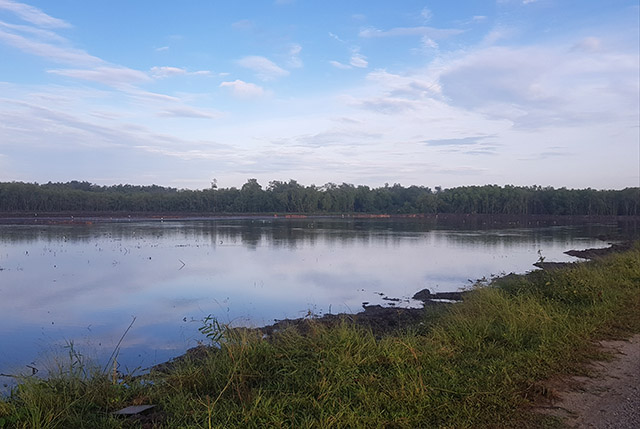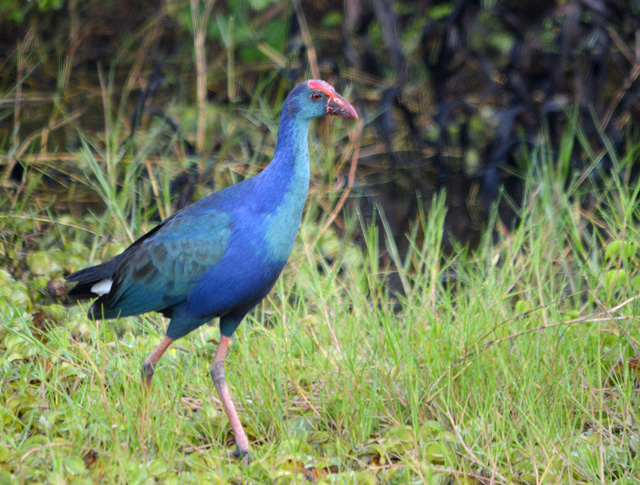Birders
share a common passion which is of course the birds. However, everyone has
their own preferences and tastes. For me, it has always been water birds. I
find it difficult to explain how a dull water bird is able to complete with a dazzling
forest bird but that is how I am built. Anyway, not all water birds are boring.
Some are unique and striking like the Pied Avocet. Even before the first Malaysian
record was discovered a few years back in Borneo, it has been one of my dream
birds. When Peninsular Malaysia’s first Pied Avocet popped up in Batu Kawan, my
home state was back in the limelight again.
I
managed to squeeze out thirty minutes on the eve of Chinese New Year to tick
this mega lifer but a second trip was inevitable because a few seconds of
watching this elegant wader in flight left much to be desired. For my second
attempt, I had the luxury of time and was greeted by the ever-conspicuous flocks
of Black-winged Stilts. It did not take long to locate the distinguished guest but
the early morning light and distance was far from ideal for photography.
The
Pied Avocet appeared to have settled in well at this wintering ground. It
sported a plumage colouration that lack the intensity of a typical adult bird
and I can only assume it is a youngster. The lighting gradually improved but unfortunately,
not the distance. However, it did not deter me from relishing this encounter.
It is a remarkable bird despite its common status elsewhere in the world. And
the record shots obtained today will just have to do.
Feeding
alongside the Pied Avocet was another rarity but unlike the former, the Pied
Stilt is gradually becoming commoner.
I
have had relatively few encounters with this species and this individual was given
its due attention despite the presence of a much rarer bird.
Sounds
unbelievable but there is a third rarity in the vicinity. The Common Ringed
Plover is a rare migrant to our shores but caution is needed to distinguish it
from the commoner Little Ringed Plover which were present in good numbers. When
I finally had the target in my binoculars, both bird and birder were flushed by
an over-zealous lorry driver. And there are still those who find it hard to
understand why I am not much of a people person. This birding hotspot is slated
for development and we actually have to go through an active construction site
to reach the locality. Anyway, here is an image of a Little Ringed Plover
probably thinking serve me right for ignoring it in the first place.
The
Pied Avocet remained in view throughout my time here but not once reducing the
distance between us. And I started paying attention to the other commoner birds
that were present like this Wood Sandpiper before calling it a day.
Up
in the north western tip of Peninsular Malaysia, there is yet another rare water
bird waiting to be added into my Malaysian life list. The Eurasian Coot was
discovered last year around Christmas and like the Pied Avocet, has found Malaysian
hospitality very accommodating. Exactly one week after my Pied Avocet chapter,
I found myself at the agricultural lands of Chuping scanning the aquatic vegetation
of a big pond for any signs of my would-be lifer. I have recorded the Eurasian
Coot before elsewhere in Asia where it is common but nothing is comparable to
home soil experience.
It
has been showing relatively well since its discovery. I tried to convince
myself there should not be any complications and the chances of dipping out is
low. But one thing I have learned from my years of birding is never to count
your lifers before they are twitched. I searched this pond and the other two
adjacent ones as well and all I could find were Eurasian Moorhens and Little
Grebes. I guess this pair of Little Grebes was just as surprised as I was that
I took the time to capture this mediocre image instead of continuing my search
for the Eurasian Coot.
Shortly
after, what appeared to be a Eurasian Moorhen with a pale frontal shield smugly
swam into view and my life list gets another nudge in the right direction.
Unfortunately,
distance again prevented me from obtaining any improvement shots despite the
star bird showing long and well for the birder in me.
Chuping
is now a pale shadow of its former self. It could be due to a number of reasons
but I can bet my bottom dollar it is all caused by humans. A female Pied
Harrier floating above the fields was a solemn reminder of the good old days.
Another thing birding has taught me is to enjoy whatever it is while it lasts.
Sad to say, I have now grown numb to losing good birding locations.
Having
said that, this locality remains to be one of the best places to see the
beautiful male Red Collared Dove and it has been quite a long time since my
last encounter. There will be no reason for this species to stop thriving here
as it can readily adapt to living alongside man.
Another
species that will not be affected by all the human activities is the migratory
Blue-tailed Bee-eater. It is common in open country habitat throughout the
length of the peninsular and it is no different here in the vast open landscape
of Chuping.
It
has been an exhilarating couple of weeks for me and hopefully all this will get
me back into the field more frequently. As a conclusion to this post, here is
an image of my new ride taken at the Coot Pond and my maiden interstate travel
with this beast of a bike was quite an experience as well. I guess motorcycles
and the sense of freedom and thrill they provide are a close second to my birding
adventures.



























































